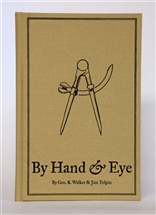Machinists are spinning in their graves at what I’m about to share and I can’t quite believe it myself. It’s hard to explain the attachment one gets to a measuring system when you’ve made a living dodging hot steel chips streaming off an engine lathe. A micrometer in my hand feels as natural as a warm coffee cup and for decades a 6” Starrett rule was never further than my shirt pocket, ready to flick a hot chip from melting into my forearm or quickly check a dimension. My mind can still rattle off fractions of an inch in thousands. Quick – what’s 3/32nds, or 7/16ths, or 63/64ths? (.093” – .437” – .984”).
For those smugly thinking I went over to the dark side and converted to the metric system, I must disappoint you also. Fact is, neither inch nor metric plays much of a role in my woodworking. I wanted to learn the language of design and looking back, my dependence on precise measurements was actually a hindrance. Some skill sets don’t translate from one endeavor to another. Skills needed for coal mining don’t apply to fly fishing. Even though I spent a lifetime building things with my hands, aided by a precision rule, it did little to help me visualize a design; in fact it got in the way.
So you are thinking Walker is off his nut advocating some leap into the unknown and I can imagine you quietly patting your tape measure to make sure it’s still within reach. Admittedly this was a gradual shift which began way back in my machinist days. The rigors of piecework forces one to jettison any motion that eats time, so I was always looking for ways to skip measurements. As I explored traditional hand tool woodworking it seemed that many of the techniques also veered away from using numerical measurements (Perhaps for those same time wasting reasons). Why bother measuring a mortise when the dimensions are built into the chisel? The traditional tool-set eased my tight grip on my precision rule and my numbers focused thinking.
Then came the big leap when I dove into the historic design literature from our craft tradition. Everything was about proportions with only the rare reference to numerical dimensions. As I stumbled through the old drawing exercises and geometry tricks, I began to realize that this went far beyond just becoming adept at drawing and layouts. Mysteriously those old drawing exercises revealed some amazing secrets. They taught my inner eye to SEE. Encouraged, I laid aside all measuring tools except dividers and a straight edge to stretch my thinking. It was like taking a wilderness trip and hearing for the first time warblers and thrushes from every treetop. Except in this case it was all about vision, and being able to imagine clearly both in my mind and as the work came together on the bench. In a nutshell, that’s what Jim Tolpin and I have been exploring together and offering to the larger craft community through our upcoming book. “By Hand and Eye”
In the end I haven’t sworn off measuring like some fire and brimstone vegetarian trying to convert a world full of carnivores. Instead I find myself simply not reaching for that ruler in lieu of something much better.
George R. Walker






Brilliant!! Look forward to reading the book.
Well said! There is a time and place for everything. To me wood working is an escape from reality. I’ve spent my life living by rules and regulations, when I go out to the woodshop or my forge I just want to do what I want and not be constrained by arbitrary measurements and what been made in the past. Sometimes things turn out great other times I chalk it up as a learning experience.
George,
I would think that those old machinest would be “turning” in their graves.
Learning to see and trust your eyes is an amazing skill. This is one of the first things you learn in a drawing class in art school.
I have students that want to measure the layout of their dovetails so they “look right”. I encourage them to try doing the layout with the same tools that they will inspect the finished project with, their eyes!
Mike,
More than likely those old dead machinists are chomping on their nasty cigars and throwing lead hammers at me!
George
George:
You refer to “the historic design literature from our craft tradition”. Could you suggest some titles while I await your book.
Thanks,
Scott
Scott,
I can offer you a few titles but be forewarned, they are daunting reads.
Thomas Sheraton 1802 “The Cabinetmakers and Upholsterers Drawing book. Note: The Dover edition clips the really good stuff, but there are on- line copies where you can get the whole text.
Batty Langleys 1741 Edition of “City and Country Workers Guide”
James Gibbs 1732 Rules for Drawing.
All these which are well documented as having been used by artisans in the pre-industrial era have and threads that run back to Albrecht Durer’s and Serlios’ treatices on perspective and design. Depends on how deep you want to dive.
George
George
Thanks for the info and very prompt reply.
Reading Vitruvius now will try one of the above when I finish that.
Scott MacLEOD